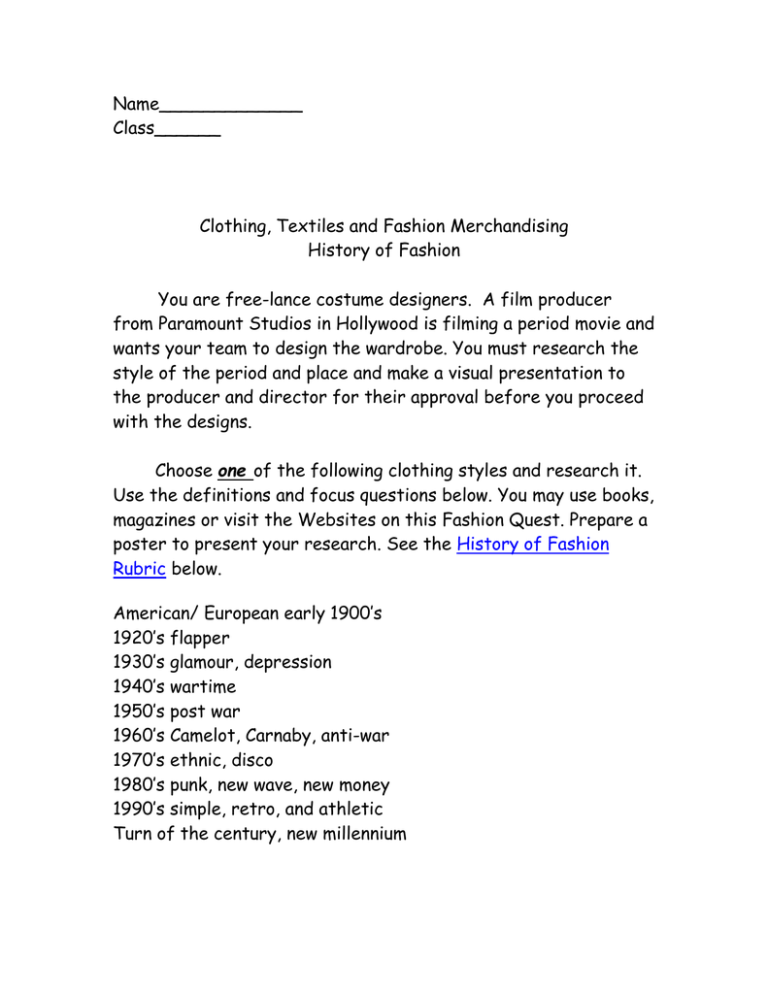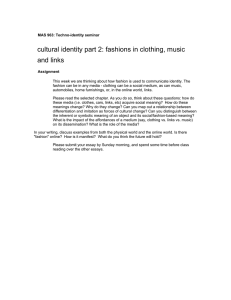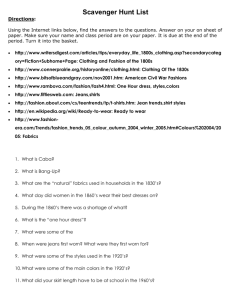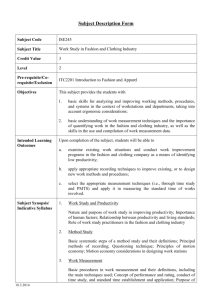Name_____________ Class______ Clothing, Textiles and Fashion Merchandising
advertisement

Name_____________ Class______ Clothing, Textiles and Fashion Merchandising History of Fashion You are free-lance costume designers. A film producer from Paramount Studios in Hollywood is filming a period movie and wants your team to design the wardrobe. You must research the style of the period and place and make a visual presentation to the producer and director for their approval before you proceed with the designs. Choose one of the following clothing styles and research it. Use the definitions and focus questions below. You may use books, magazines or visit the Websites on this Fashion Quest. Prepare a poster to present your research. See the History of Fashion Rubric below. American/ European early 1900’s 1920’s flapper 1930’s glamour, depression 1940’s wartime 1950’s post war 1960’s Camelot, Carnaby, anti-war 1970’s ethnic, disco 1980’s punk, new wave, new money 1990’s simple, retro, and athletic Turn of the century, new millennium History of Fashion Focus Questions: These questions should be answered on/in the visual and during the oral presentation. ALL TEAM MEMBERS ARE TO EQUALLY PARTICIPATE IN THE PRESENTATION. 10 minute minimum. ** THOSE DOING THIS AS A GRAD PROJECT ARE REQUIRED TO COMPLETE A 3 PAGE/ 12 FONT/ DOUBLE SPACED TYPED RESEARCH PAPER BY_________. YOU MUST USE AT LEAST 2 SOURCES AND CITE APPROPRIATELY ACCORDING TO NPHS GUIDELINES. Please use the focus questions to guide you in writing your research paper. 1. What is the style of clothing you are researching? How do the clothes reflect the country’s culture during the time period? For example: war, women’s movement, music, celebrities, hobbies, movies, politics and economics. Who in society would be wearing these styles: wealthy, middle class, teenagers, hippies, blue collar employees, etc. Give many examples of the styles typical of this time period. Show examples of men, women and children’s clothing (if applicable). The producers need to see tops, bottoms, accessories. 2. A custom is a long accepted practice or tradition. (For example, women not exposing their ankles or legs or men always wearing hats) Are there old customs that were discontinued by the introduction of the style you are researching? Were any new customs introduced? Give details and examples. 3. Clothing can reflect beliefs held by people. People’s religious beliefs or belief in magic are expressed in clothing. The Amish believe in simplicity and modesty and this is reflected in their clothing. State any beliefs represented in the style you are researching. Give details and examples 4. Clothing can reflect the values held by individuals and groups. Some people may value appearance and some may think that comfort is more important. Were the clothes worn for protection from weapons, for example, like a coat of armor What values are reflected in the style you are researching? Give details and examples 5. The term economics relates to the way people produce, distribute, and use goods and services. People were once limited to the clothes they could make for themselves unless they were wealthy. During World War II, clothing was kept very simple in order to save fabric for uniforms. Describe how economics plays a role in the style you have chosen to research. Give details and examples 6. The way a society uses its resources to produce things is referred to as its technology. Technological change has included machinery, new fabrics and mass production. In addition, modern transportation and communication has enabled people to share ideas about fashion more easily. How has technology affected the style you are researching? Was the clothing hand-made or mass produced? Who would make it? (The wearer, a tailor or seamstress, a relative, factory, etc. (Give details and examples) 7. What kinds of fabrics were used to make these clothes? Were the clothes highly decorated or plain? What were the clothes decorated with? Ruffles, lace, ribbon, feathers, fur, gems, buttons? What colors were popular? 8. What about the accessories like belts, fans, hats, veils, collars, corsets, shoes, and boots? 9. Popular Culture: Who were the celebrities of the time? What types of music were popular? What did people do for fun? Any hobbies? Movies, TV shows, games, food, etc. Who were the top designers of the decade. What designs were made them famous? 10. Compare and Contrast: Discuss with the class the similarities and differences of your chosen decade with today. History of Fashion Visual Rubric criteria Unsatisfactory (0-3) theme Visual is difficult to understand even when its purpose is explained Satisfactory (4-7) Theme is clear at first glance Exemplary (8-10) Theme is clear and well developed; more information comes out as the viewer looks at visual There is strong unity of theme and design in the visual, main ideas are clear and are supported by appropriate details. organization Visual seems like a random collection of information; there are no main ideas linking the items Visual holds together and has a sense of wholeness; there are clear main ideas Information Info presented in visual is largely inaccurate; important points are missing Info presented is primarily accurate; conveys most important points related to the theme All info is accurate and relevant to theme; visual conveys all necessary info Core concepts Students seem not to understand concepts behind the assignment Graphics are not used, detract visually, are inappropriate, or make the visual hard to understand Work is messy, unclear or visual unappealing Dull and fails to hold the viewer’s interest Students seem to grasp core concepts behind the assignment Graphics enhance the overall effectiveness of the poster Students show a highly developed understanding of the material Graphics enhance clarity and contribute to the visual impact of the poster Work is neat and presentable Work is particularly neat or attractive Is particularly attractive and compelling Graphics: pictures, photos, drawings, diagrams, graphs Neatness Visual impact Totals Comments: Total points earned: /70 Is attractive and holds the viewer’s interest Points earned



